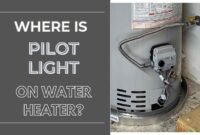Water heaters are vital in our homes, providing hot water whenever needed. However, proper venting is crucial for their safe and efficient operation. A water heater can become a safety hazard without appropriate ventilation and may not work efficiently.
Homeowners need to understand the importance of correct venting and how to ensure it’s done right.
What Should You Know About Power Vent Water Heater Venting Requirements?
Setting up the proper ventilation for your water heater involves more than just following standard guidelines. From my experience as a technician, achieving the correct size, height, and airflow is crucial for preventing issues such as back-drafting and poor combustion efficiency.
Adhering to your local and state regulations is non-negotiable, but understanding your installation environment’s specific requirements is equally important.
“The concentric venting design, where both intake air and exhaust gas share a single assembly, is an excellent solution for minimizing roof penetrations while ensuring efficient gas expulsion.”
● Venting Settings
A vent connector is necessary to direct the vent upwards through the roof. This connector should slightly tilt, rising by 1/4″ for every 12″ it runs horizontally.

It’s a gentle slope, making it easy to achieve. However, the horizontal stretch should be three-quarters of the vertical length.
If your water heater has a power vent, it is crucial to give it its flue. Don’t combine it with other appliances. Also, remember to ensure a vertical vent of at least 12″ before adding any elbow fittings.
“A minimum vent length is often required not just to meet code but to prevent the fan from drawing back expelled gases, a mistake I’ve seen too many times during inspections.”
● Chimney Pipe Clearance
Standard B-Vent chimney pipes need a space of 1″ around them. But there are also special pipes that don’t need any clearance. If you’re using a single-wall pipe, maintain a 6″ gap around it.
This type of pipe should only go through walls, ceilings, or floors if made of non-flammable materials like concrete or masonry.
How to Install a Power Vent Water Heater?
Installing a power-vent water heater requires efficiency and safety. Here are the essential steps for a successful installation.
Read also: Do You Need a Permit to Install A Water Heater?
● Location Selection
The ideal spot facilitates easy venting, preferably near an exterior wall or chimney. This proximity ensures that the venting pipes have a shorter distance to cover, reducing potential complications and ensuring the efficient expulsion of exhaust gases.
Moreover, the chosen location should be easily accessible for maintenance, repairs, and potential replacements in the future.
● Venting Setup
One significant advantage of power vent water heaters is their ability to use PVC pipes for venting. In my practice, I’ve found that PVC is cost-effective and offers more flexible installation options than traditional metal ducts.
This allows for placement flexibility, such as horizontal venting through side walls, which is often impossible with standard venting systems.
When setting up the venting system, it’s essential to ensure that the vent pipes are either directed horizontally or have a slight upward slope. This positioning provides the optimal expulsion of exhaust gases.
Next, the venting system should be free from obstructions and maintain a consistent diameter throughout to prevent backflow or gas accumulation.
“The use of PVC pipes, which are generally cheaper and easier to work with than metal ducts, is a major benefit of power vent systems, providing both cost savings and installation flexibility.”
● Electrical Setup
Power-vented water heaters come equipped with a fan that helps expel exhaust gases. This fan requires a power source, so it’s crucial to have a standard electrical receptacle nearby.
This setup powers the fan and ensures that the heater operates seamlessly. When planning the electrical layout, ensure the wiring is done professionally and adheres to local electrical codes.
● Safety Measures
Again, ensuring adequate “make-up” air in the installation area is essential. This air replaces the air expelled by the heater, providing a balanced environment and preventing any negative pressure scenarios.
A word of caution: the fan noise from power vent water heaters can be quite intrusive. From installations in quiet homes, I’ve observed that positioning the heater away from living or sleeping areas is crucial to minimizing disturbances. While some units boast quieter operation, noise remains a common concern, particularly in smaller homes.
“The noise level is one of the primary drawbacks of power vent systems; these units can be notably louder than traditional water heaters, particularly in close quarters.”
Read also: What Causes Too Much Pressure in Hot Water Heaters?
The Installation Costs
The cost of installing a power vent water heater varies depending on several factors. Tank water heaters average between $320 and $1,290, while tankless models range from $1,200 to $3,500.
The heater’s size, determined by the household’s water needs, can influence the price. For instance, a 40-gallon water heater suitable for a two-person home might cost between $320 and $1,600.
Costs can rise if the unit needs to be relocated, fuel types converted, or a specific venting system is set up.
Knowing water heater venting requirements is crucial to ensuring a warm, comfortable, and safe home environment. However, always adhere to local and state regulations.
| Venting Component | Requirement | Notes |
|---|---|---|
| Vent Pipe Material | PVC, ABS, or CPVC | Flexible installation with lower costs. |
| Minimum Vent Length | 7 feet equivalent | Prevents fan from drawing back expelled gases. |
| Clearance | 1″ for B-Vent, 6″ for single-wall | Use non-flammable materials for penetrations. |
| Vertical Venting | At least 12″ before elbows | Maintains proper exhaust velocity. |
| Noise Level | Consider placement away from living areas | Fans can be loud, especially in smaller homes. |


